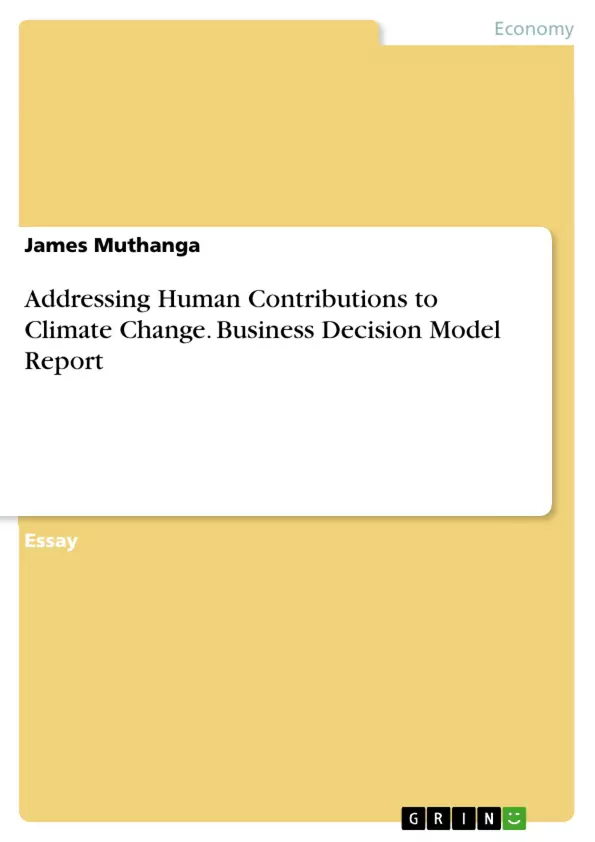Climate change is a concept used to refer to a wide range of, and long-term effects of weather patterns. Climate change is a global problem, usually caused by the excessive release of carbon dioxide into the atmosphere. The burning of wood and fossil fuels has conspicuously impacted the carbon cycle negatively, causing a substantial increase in carbon dioxide level. The carbon dioxide level has continued to rise in response to the increased conversion of organic forms during the Industrial Revolution.
Ideally, carbon dioxide has increased sharply from 280 ppm to over 400 for the past two centuries. Initially, people brushed off the idea that such an increase in carbon dioxide was due to human activities. The issue of climate change was therefore attributed to nature, and treated as a natural component. The global community has already acknowledged the implications of climate change and has been striving to reduce carbon emissions for the past few decades.
Through the United Nations Framework Convention on Climate Change (UNFCCC) and the Kyoto Protocol, a target to limit the mean global temperature rise to no more than (or as close to) 2°C by the year 2100 was established. The objective of this business decision model report is to determine a plausible set of human behavioral and policy changes that would be used to limit the mean global temperature rise to no more than (or as close to) 2°C by the year 2100 in alignment with the UNFCCC and the Kyoto Protocol directives.
Inhaltsverzeichnis (Table of Contents)
- Executive Summary
- Overview of the Project
- Introduction
- Background Information
- Problem Statement
- Assumptions
- Analysis: Solution to the Emissions Problem using the EN-ROADS Simulator
- Basic Controls
- Coal Policy
- Oil Policy
- Gas Policy
- Renewables
- Biomass
- Nuclear
- New Technology: Direct Air Capture (DAC)
- Population and GDP
- Population Growth Scenario
- GDP/Capita Growth Rate
- Carbon Policy (Emissions Price Controls)
- Land Use & Other
- Forestry Reductions
- Other Greenhouse Gases Reductions
- Basic Controls
- Recommendation and Conclusion
- References
Zielsetzung und Themenschwerpunkte (Objectives and Key Themes)
This business decision model report aims to identify a realistic set of human behavioral and policy changes to limit the global temperature rise to no more than 2°C by 2100, aligning with the UNFCCC and Kyoto Protocol directives.
- Mitigating climate change through policy and investment changes
- Analyzing the effectiveness of various policies and technologies
- Exploring the implications of global warming and its threats
- Promoting behavior change and collective action in addressing climate change
- Utilizing the EN-ROADS Simulator to assess potential solutions
Zusammenfassung der Kapitel (Chapter Summaries)
- Executive Summary: This section provides a concise overview of the report's findings and the proposed solutions for mitigating climate change. The report emphasizes the use of the EN-ROADS Simulator to analyze potential policy changes and their impact on global temperature rise.
- Overview of the Project: This chapter presents an introduction to climate change, its causes, and the historical context of the problem. The report outlines the objective of determining a plausible set of human actions to limit global warming. The chapter also provides background information on carbon dioxide emissions and their role in climate change.
- Problem Statement: This section discusses the threats and implications of global warming, emphasizing the need for immediate action to reduce greenhouse gas emissions. The chapter highlights the global trajectory of anthropogenic greenhouse gas emissions and the potential consequences if no effective measures are implemented.
- Analysis: Solution to the Emissions Problem using the EN-ROADS Simulator: This chapter delves into the analysis of various policies and technologies to address the emissions problem. The report examines the potential impact of changes in coal, oil, and gas policies, renewable energy sources, nuclear power, and technological solutions like Direct Air Capture. The chapter also considers the role of population growth and GDP in influencing climate change.
Schlüsselwörter (Keywords)
This report focuses on climate change, mitigation strategies, greenhouse gas emissions, carbon dioxide, policy changes, EN-ROADS Simulator, renewable energy, nuclear power, Direct Air Capture, population growth, GDP, and the UNFCCC and Kyoto Protocol directives.
- Citation du texte
- James Muthanga (Auteur), 2023, Addressing Human Contributions to Climate Change. Business Decision Model Report, Munich, GRIN Verlag, https://www.grin.com/document/1354863



